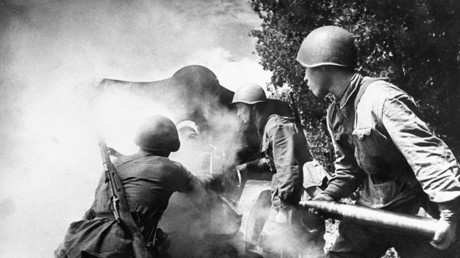‘We were going deaf from the cannons’: Nazi Siege of Leningrad lifted 75 years ago
The Nazi siege of Leningrad during World War II, regarded as one of the longest and deadliest in history, was lifted on January 18, 1943. RT recalls the sacrifices of the people and the fierce battle to break the blockade.
The people in Leningrad (modern day St. Petersburg), who had to resort to eating rats, their pets and even glue in order to survive, still donated blood for wounded frontline soldiers fighting the Nazis. Between the Nazi invasion of the Soviet Union on June 22, 1941 and the end of that year, 25,865 people had become donors in the besieged city, according to a newly-released documentary entitled, 'The Siege Blood.'
The entire Leningrad Front was aided solely by the blood provided by the city’s population. A special blood substitute fluid was developed at the local Blood Transfusion Institute. It contained 10 percent of blood type O, which could then be transfused to a person with any of the four blood types.
Every frontline nurse carried what came to be known as the "Leningrad vial," – a container filled with the substitute blood and fitted with a special device to allow direct transfusions on the battlefield. The blood in the vials saved numerous lives at a time when it was declared a strategic resource, on par with metal and gasoline.
There were about 5,000 type O carriers in Leningrad during the siege, according to the documentary. In 1944, 2,000 people were recognized for their heroics when an Honorable Donor Pin was introduced in the Soviet Union. The rest had died of hunger, cold or killed by Nazi bombs.
For many, sharing their blood became a means of survival. The local authorities provided additional food supplies to the donors in addition to the strict daily rationing of just 125 grams of bread. The scriptwriter of 'The Siege Blood,' Leningrad native Dmitry Karalis, told Rossiyskaya Gazeta his mother became a donor in order to save his sister, who had been born a month before the start of the siege.
The donor rations were not much, though, consisting of some 200 grams (less than half a pound) of bread, 40 grams of meat, 30 grams of fish, 30 grams of butter, 30 grams of sugar and half an egg for the ten days before the blood donation, which amounted to 170 ml (some 6 oz) once a month. Still, Karalis says, the meager increases in the rations allowed his infant sister, who is now 77 years old, to survive the horrors of the time.
The blockade of Leningrad was smashed on January 18, 1943, as part of the Red Army’s Operation Iskra ("Spark"). The battle lasted over two weeks and saw thousands killed on both sides. Mikhail Udaltsov, who took part in the fighting, told Sputnik the Russian offensive was preceded by a massive artillery barrage.
“Cannons were hitting from all sides – we were going deaf from the cannonade,” he recalled.
"We were given a sled with a shield. Pushing the sled with long sticks and hiding behind the shield, we forced our way to the other bank [of the Neva river]. There was shooting all around us. Everybody shouted whatever they could. Everybody wanted to survive. They fell, they rose, and went on running."
Upon reaching the other bank, where the Nazi troops were positioned, Udaltsov and his comrades abandoned the shield-sled. But then, “it turned out that the German dugouts were not damaged by the artillery. We were met with intense machine-gun fire.”
This is where the Soviets suffered the most casualties, Udaltsov said. The Nazis had poured water on the banks of the Neva and let it freeze over, making the climb near impossible, and leaving the attacking Red Army troops in the open. The attack succeeded nevertheless, and the siege of Leningrad was broken.
When the Shlisselburg fortress, located at the head of the Neva River on Lake Ladoga, was liberated, all 19 ditches outside were filled with bodies of thousands of people, Udaltsov recalled.
The siege of Leningrad began on September 8, 1941. For 872 days, the city was cut off entirely from the rest of the country with no food or vital supplies and under constant enemy shelling and bombing. The dire situation was made even worse by the extreme winter of 1941-42, when temperatures plunged to -40 degrees Celsius (-40 Fahrenheit). This left the city's water supply network frozen. The total civilian death toll from a combination of hunger, cold and Nazi bombs, is still unclear. It is estimated that at least 600,000 people perished, but the real number could well be over a million casualties.





